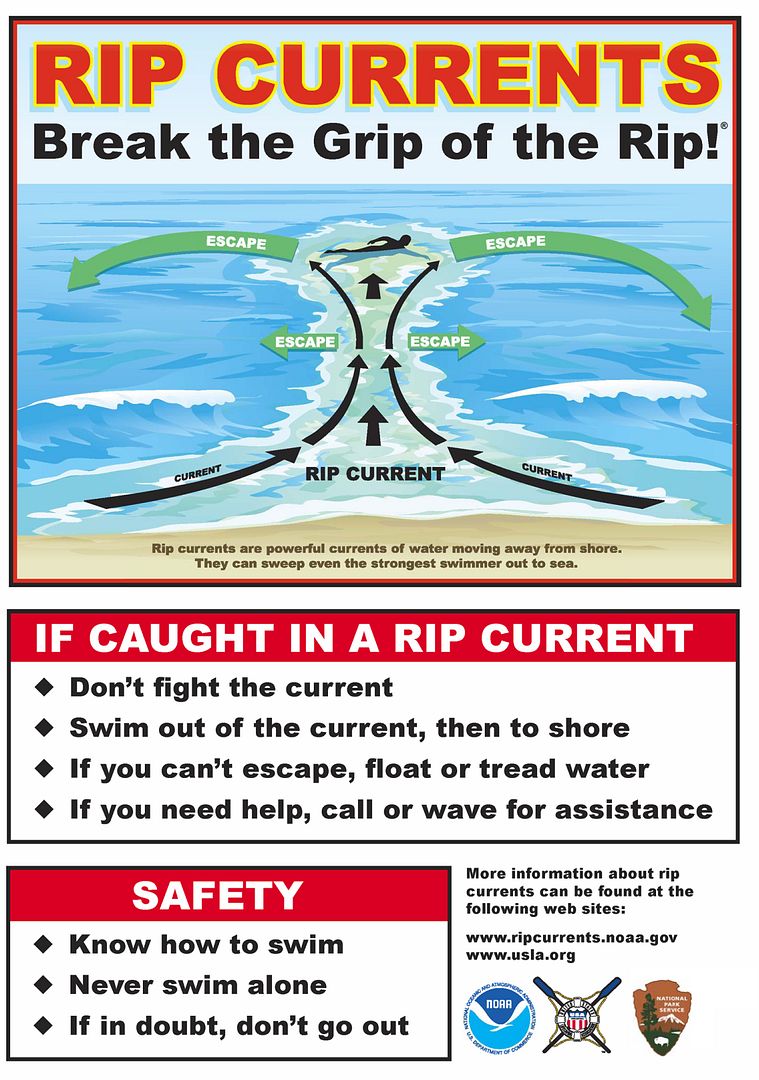This past weekend I spent the majority of both Saturday and Sunday on the beach with my friends. And in the eleven or so hours I spent on the beach, at two different beaches I might add, I saw the lifeguards calling people out of the water/rescuing people at least twelve times because of the rip current -- For those of you that don't know, rip currents are powerful, fast-moving channels of water (Up to 8 feet per second) that typically flow from the shoreline to beyond the area where waves break.
Thankfully none of those incidents that I witnesses were fatal. But unfortunately after the beach closed on Saturday someone, an out of towner, drowned. And as horrible as it may sound, it's always an out of towner that needs to be rescued or dies (Whenever anyone hears a helicopter in our area they say "An out of towner must have drowned..." and 98% of the time they're right). People from my community live and breathe the beach, thus they know the power of the ocean. So much so, they teach all the children in elementary school how to swim and what to do in the case of something like getting pulled out by a rip current -- Which isn't something they do elsewhere on Long Island.
And since this isn't common knowledge for non-beach community people I thought I'd share some information on what to do if one is caught in a rip current from National Oceanic & Atmospheric Administration, as well as other various websites.
Here are some things to do according to the National Oceanic & Atmospheric Administration if caught in a rip current:
- Keep calm. Don't fight the rip current.
- To get out of the rip current, swim sideways, parallel to the beach. This will get you out of the rip current so you can swim back in with the waves helping you along.
- When out of the rip current, swim at an angle away from the rip current and toward shore.
- If you can't escape this way, try to float or calmly tread water. Rip current strength eventually weakens offshore. When it does, swim away from the rip current toward shore.
- If at any time you are unable to reach the shore, draw attention to yourself: face the shore, wave your arms, and yell for help.
- Break The Grip Of The Rip
- National Geographic's Rip Current Site
- Rip Currents 101
- Minnesota Sea Grant Great Lake Info
- Wave & Rip Current Training Modules
- Centers For Disease Control & Prevention (CDC) Fact sheet on drowning deaths, with links to the healthy swimming site.
- Sea Grant: Safety Checklist
- Michigan Sea Grant: Dangerous Currents
- Ripcurrents.com Increasing Rip Current Awareness Through Safety and Education
* For those of you who don't know who Sister Pooh is, here is the glorious video she posted on going into the oceans...

This is a very good reminder. I have almost always lived near the ocean, but even still I sometimes forget about rip currents. Luckily I've never gotten stuck in one, but it is so scary what could happen.
ReplyDeleteAlso, that Sister Pooh video is freaking hilarious and I don't even know how many times I've watched it.
A lot of people forget about them and they've been a problem out here. The city where I'm from went as far as to ban people from the ocean the other day.
DeleteOh, I love that video of Sister Pooh. Have you seen any of her other ones? She is amazing.